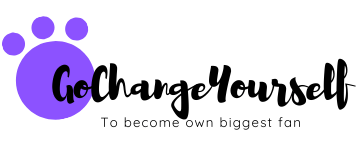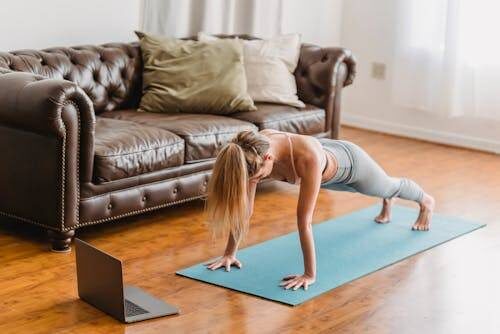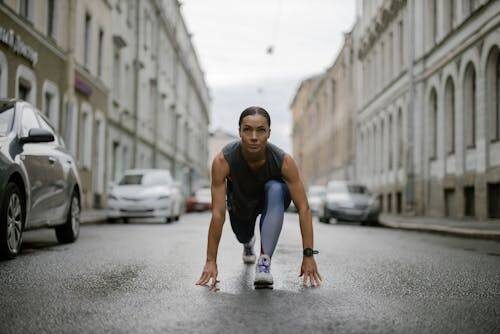In today’s fast-paced world, finding time and access to gym equipment can be challenging. However, transforming your body doesn’t require a fancy gym membership or expensive gear. With determination and a few dynamic exercises, you can achieve a full body workout without equipment that targets every major muscle group.
This article “Full Body Workout Without Equipment” will guide you through 7 game-changing exercises that will not only help you build strength and endurance but also set you on a path to total body transformation—all from the comfort of your home.
Whether you’re a beginner or an experienced fitness enthusiast, these exercises offer scalable progressions and actionable plans to suit every fitness level. So, get ready to sweat, challenge your limits, and unlock the secrets to a powerful, well-rounded workout.
Table of Contents
1. Push-Ups: The Foundation of Upper Body Strength
Push-ups are a timeless exercise that targets your chest, shoulders, triceps, and core. They are highly effective because they engage multiple muscle groups simultaneously, making them an essential component of any full body workout without equipment.
Actionable Plan:
- How to Do It: Start in a plank position with your hands placed shoulder-width apart. Lower your body slowly until your chest almost touches the floor, then push back up to the starting position.
- Modifications: If standard push-ups are too challenging initially, begin with knee push-ups. To increase the difficulty, experiment with decline push-ups by elevating your feet on a stable surface.
- Routine Tip: Aim for 3 sets of 10-15 repetitions. As your strength improves, gradually increase the number of reps or explore more challenging variations.
2. Squats: Building a Strong Lower Body
Squats are fundamental for developing strong legs and glutes while also engaging your core for stability. This compound movement is crucial for building a solid foundation and can be performed anywhere, making it perfect for a full body workout without equipment.
Actionable Plan:
- How to Do It: Stand with your feet shoulder-width apart. Lower your hips by bending your knees and pushing your glutes back, as if you’re sitting into an invisible chair. Keep your chest up and your knees aligned with your toes, then push through your heels to return to the starting position.
- Focus Points: Maintain proper form by ensuring your knees don’t cave inward and that you go as low as your flexibility allows.
- Routine Tip: Start with 3 sets of 15-20 repetitions. Increase depth and add variations like jump squats as you build confidence and strength.
3. Lunges: Enhancing Balance and Coordination
Lunges are excellent for targeting your quads, glutes, and hamstrings while also challenging your balance and coordination. They help in developing unilateral strength, ensuring both sides of your body work evenly.
Actionable Plan:
- How to Do It: From a standing position, step forward with one leg and lower your hips until both knees are at approximately 90-degree angles. Keep your front knee aligned over your ankle, then push back to the starting position.
- Variations: Mix up your routine with reverse lunges or walking lunges to keep your muscles guessing.
- Routine Tip: Complete 3 sets of 12 repetitions per leg, focusing on smooth, controlled movements to maximize muscle engagement.
4. Plank: The Ultimate Core Stabilizer
A strong core is essential for overall body strength and injury prevention. The plank is a simple yet highly effective exercise that targets your abdominal muscles, lower back, shoulders, and glutes, ensuring a well-balanced workout.
Actionable Plan:
- How to Do It: Begin in a forearm plank position with your elbows directly under your shoulders. Keep your body in a straight line from head to toe, engaging your core by drawing your belly button towards your spine.
- Progressions: Challenge yourself further with side planks or extended planks that push your limits.
- Routine Tip: Aim to hold the plank for 30-60 seconds for 3 sets. As your endurance improves, gradually extend the time or add subtle movements like leg lifts to intensify the exercise.
5. Burpees: The Total Body Powerhouse
Burpees are a high-intensity exercise that combines strength training with cardiovascular benefits. They work your entire body, including your chest, arms, legs, and core, and are excellent for boosting endurance and explosiveness.
Actionable Plan:
- How to Do It: Start standing, then drop into a squat position with your hands on the ground. Kick your feet back to enter a plank position, perform a push-up, jump your feet back to the squat position, and finish with an explosive jump upward.
- Modifications: If the full burpee is too demanding at first, eliminate the push-up or reduce the jump intensity. Build up your stamina gradually.
- Routine Tip: Perform 3 sets of 8-10 burpees, focusing on fluid transitions between movements to maximize efficiency and effectiveness.
6. Mountain Climbers: Cardio Meets Core
Mountain climbers are dynamic, fast-paced exercises that elevate your heart rate while engaging your core, shoulders, and legs. This movement not only improves cardiovascular health but also enhances agility and coordination.
Actionable Plan:
- How to Do It: Start in a high plank position. Drive one knee toward your chest and then quickly switch legs, as if you’re running in place horizontally.
- Execution: Maintain a steady pace and focus on keeping your hips level. This prevents lower back strain and ensures you’re engaging your core effectively.
- Routine Tip: Aim for 3 sets of 30-45 seconds. As you build stamina, increase the speed or duration to continuously challenge your cardiovascular system.
7. Glute Bridges: Strengthening the Posterior Chain
Glute bridges are key to building strength in your glutes, lower back, and hamstrings. A strong posterior chain not only improves your overall physique but also supports better posture and reduces the risk of lower back pain.
Actionable Plan:
- How to Do It: Lie on your back with your knees bent and feet flat on the floor. Press through your heels to lift your hips upward, squeezing your glutes at the top of the movement. Slowly lower back down.
- Variations: For increased difficulty, try single-leg glute bridges, ensuring you maintain balance and proper form throughout.
- Routine Tip: Start with 3 sets of 15-20 repetitions. Focus on controlled movements and a strong contraction at the peak of each lift.
Crafting Your Full Body Workout Routine
With these 7 game-changing exercises, you can create a comprehensive, no-equipment workout plan that targets every muscle group. Here’s how to integrate them into a balanced routine:
- Warm-Up: Begin each session with 5-10 minutes of light cardio or dynamic stretches (e.g., jogging in place, jumping jacks, or arm circles) to prepare your muscles and prevent injury.
- Circuit Training: Perform one set of each exercise in succession with minimal rest between movements. Once you complete the circuit, rest for 1-2 minutes.
- Repeat: Aim to complete 3-4 circuits per session, adjusting the number of repetitions or duration based on your fitness level.
- Cool Down: Conclude your workout with 5-10 minutes of static stretching to enhance flexibility and reduce muscle soreness. Focus on the muscles you worked during your session.
- Progress Tracking: Keep a fitness journal to record your reps, sets, and any modifications. Tracking your progress is a powerful motivator and helps you set incremental goals.
Additional Tips for a Successful Home Workout
- Consistency is Key: Establish a regular workout schedule that fits your lifestyle. Whether it’s three days a week or daily sessions, consistency will lead to lasting results.
- Mind Your Form: Correct form is crucial to prevent injuries and maximize exercise effectiveness. Consider watching video tutorials or seeking feedback until you feel confident in your technique.
- Stay Hydrated: Even if you’re working out at home, keeping your body hydrated is essential. Always have a water bottle within reach.
- Listen to Your Body: While pushing your limits is part of growth, be mindful of your body’s signals. Rest when necessary and avoid overtraining to ensure long-term progress.
Conclusion
A full body workout without equipment is not only accessible but also remarkably effective for achieving total body transformation. The 7 exercises detailed above—Push-Ups, Squats, Lunges, Plank, Burpees, Mountain Climbers, and Glute Bridges—offer a well-rounded approach to strength, endurance, and overall fitness.
By incorporating these movements into a structured routine, you can experience significant improvements in muscle tone, cardiovascular health, and functional strength without stepping foot in a gym.
Remember, the journey to a healthier, stronger you is built on consistency, proper technique, and gradual progression.
Embrace these exercises as part of your fitness arsenal and commit to a routine that challenges and motivates you. Start your workout today, track your progress, and enjoy the transformation that comes with regular, dedicated training.
Happy training, and here’s to unlocking your full potential with a workout routine that truly transforms your body—no equipment required!
FAQ:
Q1: What is a full body workout without equipment?
A1: It is an exercise routine that utilizes bodyweight movements to target all major muscle groups, eliminating the need for any gym equipment.
Q2: What are the main benefits of a full body workout without equipment?
A2: Benefits include improved strength, endurance, flexibility, and balance, all while being accessible and convenient to perform anywhere.
Q3: How do push-ups contribute to a full body workout?
A3: Push-ups primarily strengthen the chest, shoulders, triceps, and core, making them a foundational exercise for building upper body strength.
Q4: What modifications can beginners make when performing push-ups?
A4: Beginners can start with knee push-ups or wall push-ups, gradually progressing to standard or decline push-ups as their strength improves.
Q5: How do squats help in building lower body strength?
A5: Squats target the quadriceps, hamstrings, glutes, and core, helping to develop strong legs and overall lower body stability.
Q6: What key form tips should be remembered when doing squats?
A6: Keep your feet shoulder-width apart, ensure your knees track over your toes, keep your chest up, and lower your hips as if sitting into a chair.
Q7: Why are lunges beneficial for a full body workout?
A7: Lunges improve balance and coordination while targeting the quads, glutes, and hamstrings, enhancing unilateral strength across your lower body.
Q8: What variations of lunges can be added to the routine?
A8: You can incorporate reverse lunges, walking lunges, or even lateral lunges to challenge your muscles from different angles.
Q9: How does the plank exercise benefit core stability?
A9: The plank engages the entire core, including the abs, lower back, and glutes, while also working the shoulders and stabilizing muscles throughout the body.
Q10: What progression steps can be taken to make planks more challenging?
A10: Increase the duration of the hold, incorporate side planks, or add dynamic movements like leg lifts to further engage the core.
Q11: What makes burpees a game-changing exercise in this routine?
A11: Burpees combine strength and cardio by engaging multiple muscle groups—including the chest, arms, legs, and core—in one explosive, full-body movement.
Q12: How can beginners modify burpees to suit their fitness level?
A12: Beginners can remove the push-up or jump component, focusing on the basic movement before progressing to the full burpee.
Q13: What are the benefits of incorporating mountain climbers into your workout?
A13: Mountain climbers boost cardiovascular endurance while strengthening the core, shoulders, and legs, making them a dynamic and effective exercise.
Q14: What is important to focus on when performing mountain climbers?
A14: Maintain a steady pace with hips level and engage your core consistently to avoid lower back strain and maximize the exercise’s benefits.
Q15: How do glute bridges enhance your overall workout?
A15: Glute bridges target the glutes, hamstrings, and lower back, helping to build a strong posterior chain and improve overall stability and posture.
Q16: How can you increase the difficulty of glute bridges?
A16: Progress by performing single-leg glute bridges, which intensifies the muscle engagement and challenges your balance and strength further.
Q17: How should these 7 exercises be structured into a workout routine?
A17: Incorporate them into a circuit training format by performing one set of each exercise in sequence with minimal rest, repeating for 3-4 circuits per session.
Q18: What is the recommended warm-up before starting a full body workout without equipment?
A18: Engage in 5-10 minutes of light cardio or dynamic stretching (such as jogging in place or jumping jacks) to prepare your muscles and reduce injury risk.
Q19: What are the benefits of circuit training in this context?
A19: Circuit training increases the workout’s intensity, boosts cardiovascular health, and ensures all major muscle groups are engaged efficiently.
Q20: How can I track my progress in a full body workout routine?
A20: Maintain a fitness journal to record your sets, repetitions, and any modifications, helping you set incremental goals and monitor your improvement over time.
-
10 Superfoods for Healthy Eyes That Boost Your Vision
Let’s be honest — we don’t always treat our eyes the way they deserve. From binge-watching late-night shows to scrolling endlessly through social media, our vision takes a lot. The problem? We often forget how crucial eye health really is… until something starts to go wrong. The good news? You don’t need to wait for…
-
Importance of Taking Risks for Success
Let’s face it—taking risks is scary. Whether it’s quitting a job, starting a business, or even just speaking up in a meeting, the idea of stepping outside what’s familiar can feel downright uncomfortable. But here’s the thing: most people who achieve real success didn’t get there by playing it safe. They took leaps. They bet…
-
What to do After Layoff ? | 7 Steps to Bounce Back Stronger and Smarter
Losing your job is one of those moments that just hits differently. It’s not just about the paycheck—it’s about routine, identity, even pride. One minute you’re gearing up for a busy quarter, and the next, you’re trying to figure out what the heck just happened. If you’re sitting there wondering what to do after layoff,…







